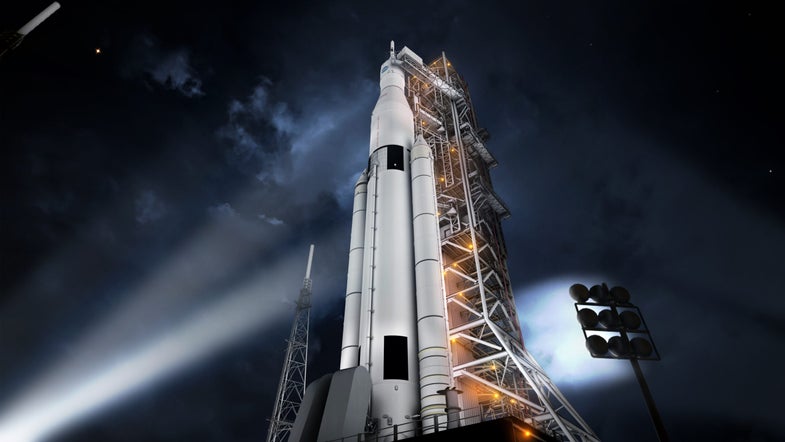NASA May Be Cutting Corners On Safety Of Mars Rocket And Capsule, Report Finds
Budget and scheduling constraints could put astronauts at risk

Space has always been a risky endeavor. But according to the latest report from the Aerospace Safety Advisory Panel (ASAP), which makes safety recommendations to NASA, the space agency is not being careful enough. The latest report criticizes several aspects of the Orion capsule and the Space Launch System (SLS) that NASA is designing to bring astronauts to Mars in the 2030s.
The report blames the safety concerns on budget pressures and a lack of accountability.
“Funding remains a challenge for NASA as it strives to do so much with so relatively little,” ASAP writes. “NASA’s budget is insufficient to deliver all current undertakings with acceptable programmatic risk.”
In other words, cutting corners to stay on schedule and under budget could put astronauts at risk. The report points out several safety concerns.
Some critical components won’t be thoroughly tested before crewed missions
Heat shields
After a test flight in December 2014, the Orion team found cracks in some of the seams of the spacecraft’s heat shield. That’s not good, since spacecraft face temperatures of up to 3,000 degrees when they’re reentering the Earth’s atmosphere from space. As a result, Orion engineers have had to make changes to the heat shield design.
NASA hasn’t really explained how it plans to test the new heat shield design. Under the current plans, the report notes, the only opportunity to flight-test the new heat shield will be on the Space Launch System’s first flight in 2018–and the next one after that will be a crewed launch in 2021 or 2023. That thought probably won’t be terribly comforting to the astronauts who’ll be flying on that mission.
“In our opinion,” ASAP writes, “the test of the new Orion heat shield has become one of the most important mission objectives.”

A mock-up of the Orion capsule
Life support
Under the current schedule, the first crewed launch of the Orion capsule will also be the first to try out the spacecraft’s “environmental control and life support system.” This mission is currently scheduled as a sortie to lunar space–a trip that could take up to 11 days.
“This system will not have had an end-to-end flight test to build confidence that it will function safely during a [lunar orbit] mission,” says the report. “This plan appears to incur an increased risk without a clearly articulated rationale.”
A better idea, the report suggests, would be to first test the life support system in low Earth orbit, where astronauts could return to Earth in as little as one to two hours using an emergency de-orbit procedure.
Launch abort system
To save money, the report says, NASA has had to whittle down its testing. The first SLS flight in 2018 will be the first to test the heat shield, a functional (uncrewed) Orion module, and the SLS itself. During this test, ASAP says the launch abort system motor will be deactivated.
The launch abort system is the system that, if the rocket explodes during launch, ejects the Orion capsule and carries the humans inside to safety.
ASAP would prefer to see a more realistic, activated abort system tested on the 2018 flight. This “is the only opportunity to flight test the LAS and its interactions with many other Orion systems in the challenging transonic flight environment,” the panel notes.
The abort system will be flown on every mission for the next 40 years, and is “the last hope for the crew if something goes wrong during the early phase of ascent.”
Questions about the rocket’s upper stage
The upper stage of the SLS–the part of the rocket that will propel Orion toward the moon in its 2018 mission–is not rated to be flown with humans onboard. That means NASA will either have to modify that stage to make it safe for a crewed mission, or come up with a new one.
In an email to Popular Science, NASA press officer Kathryn Hambleton said NASA is currently planning to fly the SLS’s first crewed mission with a brand new upper stage. There is no guarantee that upper stage will be flight-tested before it carries humans toward the moon in SLS’s second mission.
“There is no requirement for a validation flight before flying crew with [the new upper rocket stage],” Hambleton wrote.

The Space Launch System
What’s the rush?
Many of the safety concerns listed here–particularly the ones regarding adequate safety testing–exist because the agency is doing its best to launch the first crewed mission of Orion and SLS by 2023. The original goal was to achieve that flight in 2021, and NASA has said that although 2023 is more realistic, they are still working toward a 2021 goal.
“What is the compelling reason to adopt these measures to maintain a 2021 schedule that appears to be unrealistic by NASA’s own analysis?” the panel asks. “Why is it important to fly crew on [the second SLS flight]?”
NASA’s “Journey to Mars” in the 2030s is still lacking many other critical components–such as adequate food supplies and a safe living space. Why rush, putting human lives at risk, just to put the cart before the horse, so to speak?
Each launch of the SLS is expected to cost $500 million or more, which is probably a significant factor in NASA’s trying to pack as much testing into as few missions as possible. Of all the problems reported in the study, budgeting issues were listed at the top. Perhaps it’s either time to rethink NASA’s budget, or else rethink our expectations for America’s space agency.